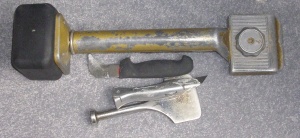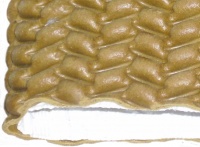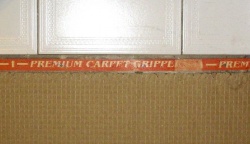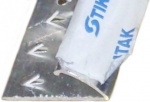Difference between revisions of "Carpet laying"
(pic→Tacks) |
(→Re-using grip rods: glue) |
||
| Line 61: | Line 61: | ||
* Check for buildup of muck on the top of the grip rod | * Check for buildup of muck on the top of the grip rod | ||
* Clear muck out from the gap between grip rod and wall | * Clear muck out from the gap between grip rod and wall | ||
| + | * If grip rods are in poor condition, spraying them with glue helps ensure the carpet sticks. | ||
===Re-using aluminium edging=== | ===Re-using aluminium edging=== | ||
Revision as of 17:56, 26 February 2011
This is about how to lay a carpet. For more carpet info see Carpet
Floor defects
One of the functions of underlay is to hide floor defects. There are limits of course, but underlay can hide a 5mm gap.
Carpets laid with no underlay are much less forgiving of floor defects, and sometimes show up the ripple of every floorboard. Underlay is the usual recommendation, but there are other usable materials too, namely hardboard or old carpet.
- Old carpet works but has its issues, and is addressed in the Carpet article
- Hardboard can resolve quite rough floors, and blocks smoke ingress through floorboards in a fire
Concrete floors can have large gaps filled and cracks that change level smoothed with epoxy mortar.
- Where the cost of epoxy mortar is out of the question, ordinary cement mortar with lots of pva can be used, but its not very robust used like this. Brushing PVA onto it after filling the gaps helps.
- Levelling compound is also an option
- anyone tried wall filler?
Newspaper
With foam rubber backed carpets, its best to lay down newspaper first over the areas that don't need to be glued. Otherwise in time, the rubber tends to stick itself to the floor.
Underlay
Ribbed underlay is best laid with the flat side uppermost. The flat side contains anti-stretching fibres to minimise carpet stretch when trodden on, helping to prolong carpet life.
Underlay can be fixed in place with a little spray glue, or just left unfixed, relying on carpet weight & friction. Both methods are used. When gluing its better to stick it to the carpet above rather than the floor underneath, it makes removal easier.
See Carpet re choice of underlays.
Carpet Fixing methods
Gripper rods
When fitting underlay as well, gripper rods are the best option.
- These are only suitable for carpet plus underlay though.
How grip rods work
- Grip rods are fitted all round the floor perimeter, leaving a gap of about 1/4" between grip rod and walls. The pins point toward the wall, and the sloping edge goes nearest the wall.
- Underlay is laid out over the floor. It reaches the grip rod, but doesn't go over the top of it at all.
- Carpet is laid flat, smoothed. There are then 2 ways to fit it to the grip rods:
- 1. Cut carpet to reach the wall plus half an inch. Whack it into the gap behind the grip rod using a wide bladed scraper (3-4" blade). This action pulls the carpet very slightly. Don't cut the carpet at 2 opposite walls before fitting it to the gripper, as fitting it moves the carpet slightly.
- 2. Cut carpet to meet the wall. Stretch it half an inch with a knee kicker, and press it into the grip rod gap using a rounded knife. (The rounded back of a kitchen knife could be used if necessary.)
Fixing grip rods
- Grip rods are nailed to wooden floors.
- Grip rods will sometimes nail into to concrete floors
- A quick setting glue may be used on concrete. 5 minute polyurethane is good, as shown.
Re-using grip rods
Grip rods can usually be reused, but needing to replace some due to deterioration is normal.
- Check all are firmly fixed
- Check for rusted carpet gripping nails. If found, replace the strip
- Check for buildup of muck on the top of the grip rod
- Clear muck out from the gap between grip rod and wall
- If grip rods are in poor condition, spraying them with glue helps ensure the carpet sticks.
Re-using aluminium edging
The spikes on used ali edging tend to be flattened down, and won't grip. Either
- replace the edging strip
- spray glue into the strip and insert the carpet immediately.
- or even re-raise the spikes using a scraper or very small screwdriver.
Tacks
Tacking is cheap, but leaves a slighty wavy edge, and isn't as good at preventing fray as grip rods. A good option if you're broke.
- Tacks are only suitable for wooden floors.
- The tack points bend over in the wood to resist pullout.
- Lay carpet in place, and smooth carpet out to avoid wrinkles
- Cut carpet to walls
- Hammer tacks in along the edges. Avoid pipes & wires!
Glue
Good option for foam backed carpets
- Lay carpet in place, and smooth carpet out to avoid wrinkles
- Cut carpet to fit
- Peel back carpet edge, spray glue down and replace carpet. Done.
There are various carpet glues avaiable
- spray solvent based glue - very quick set
- water based - slow to dry
- rubber resin - very tough
Tackifier
This is similar to glue, but remains permanently peelable. Ideal for carpet tiles where you want to be able to replace one if it gets damaged.
- Apply by brush or roller
- Let it set before laying the carpet
Tape
For foam backed carpets
- lay tough double sided carpet tape down
- Lay carpet in place, and smooth carpet out to avoid wrinkles
- Cut carpet to fit
- Peel back carpet edge, peel off tape covering strip, replace carpet. Simples.
Don't be tempted to use another tape type with adhesive that may creep over time.
Stair rods
Stair rods were once used to fix carpet to stairs. However their failure can cause a serious accident, so using them only as a secondary decorative method is best.
The carpet is tacked in place at top and bottom, and a stair rod is fitted over the top of the carpet to the rear of each step. The carpet must be narrower than the rod assembly.
No fixing
The carpet is just laid down without fixing it. It then turns up at the edges, moves & wrinkles. Wrinkles and turnups are a trip hazard. Not recommended.
Detailing
Grip rods
Pipe
Where a pipe comes out of the floor, just cut the carpet around it. No need for any fixings if its just a pipe upto 28mm.
Curved edges
When carpeting round a curved item, such as a sink pedestal, fit several very short bits of grip rod to go round it. The quarter inch spacing need not be precise.
Carpet meets tiles
The top of the tiles will be slightly higher than the floor getting carpeted, so use grip rod the same way as with walls.
Carpet meets bare floor
eg at doorways. Use an aluminium door strip like so
Carpet meets carpet
Use an aluminium carpet to carpet door strip like so
Carpet meets vortex of hell
Sod the carpet
Step down threshold
In the diagrams below,
_ /__ is an aluminium door strip : is a grip rod
There are 2 ways to do this:
________________ floor
|
_ :| Here the carpet goes down the step
/_____| plus horizonally a very short distance
________________ floor
|
| Here the carpet goes down the step
_____:| and stops where it meets the floor
Missing a bit
If you end up missing a little piece of gripper, with nothing to replace it, don't worry. Just run both underlay and carpet right upto the wall there. Only do this for small lengths though, upto about 7".
Joining Carpet
If a join's necessary, use carpet tape. Don't use anything less tough, and don't use another tape type with an adhesive that creeps over time.
Pile loss
Some pile loss after fitting is normal with some carpets.




